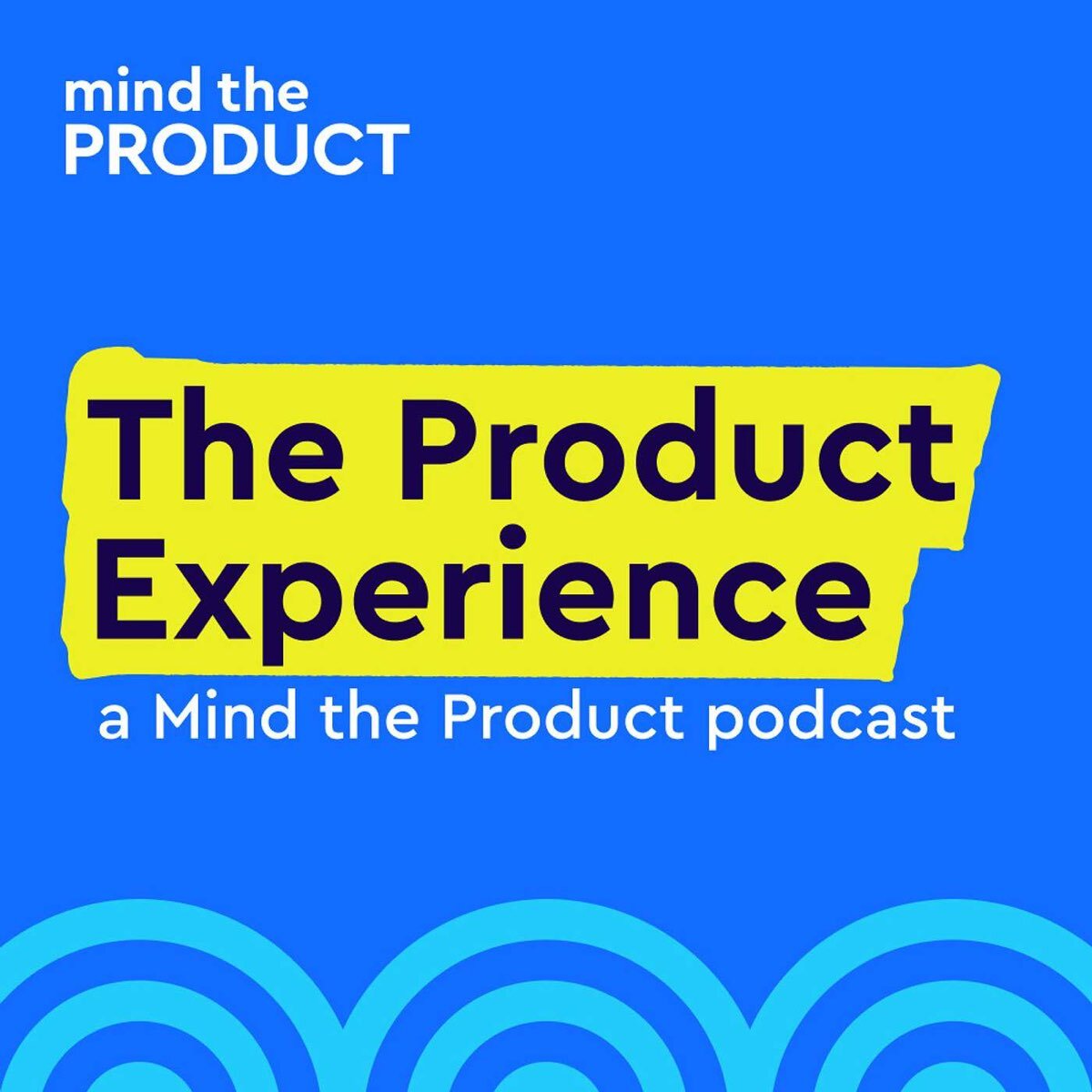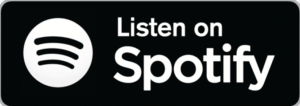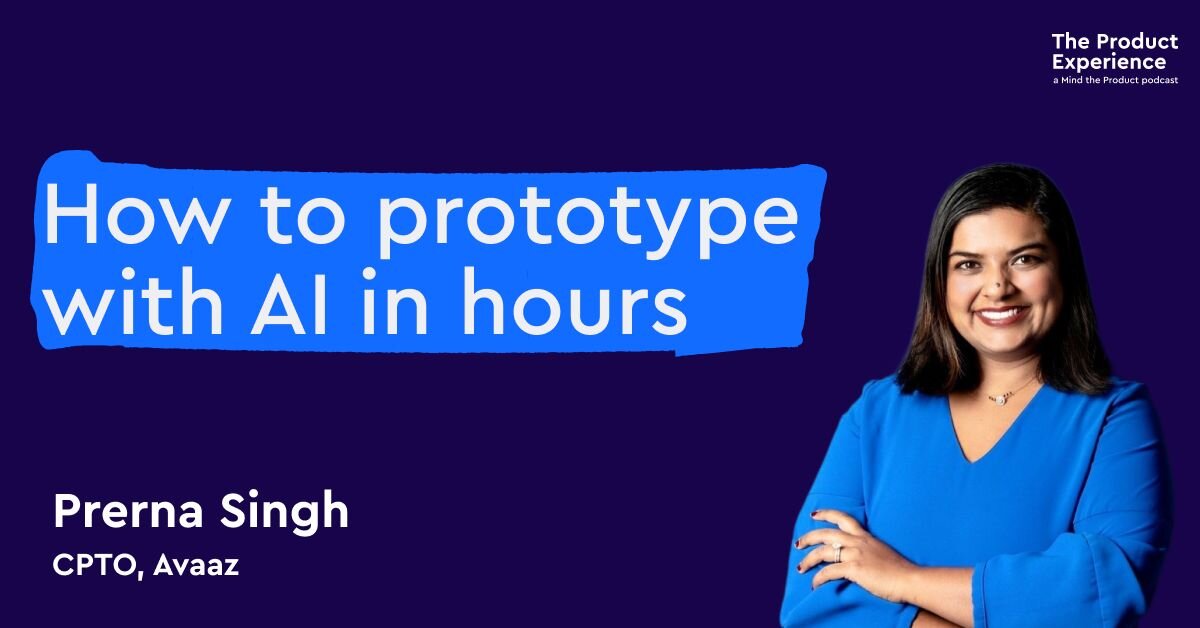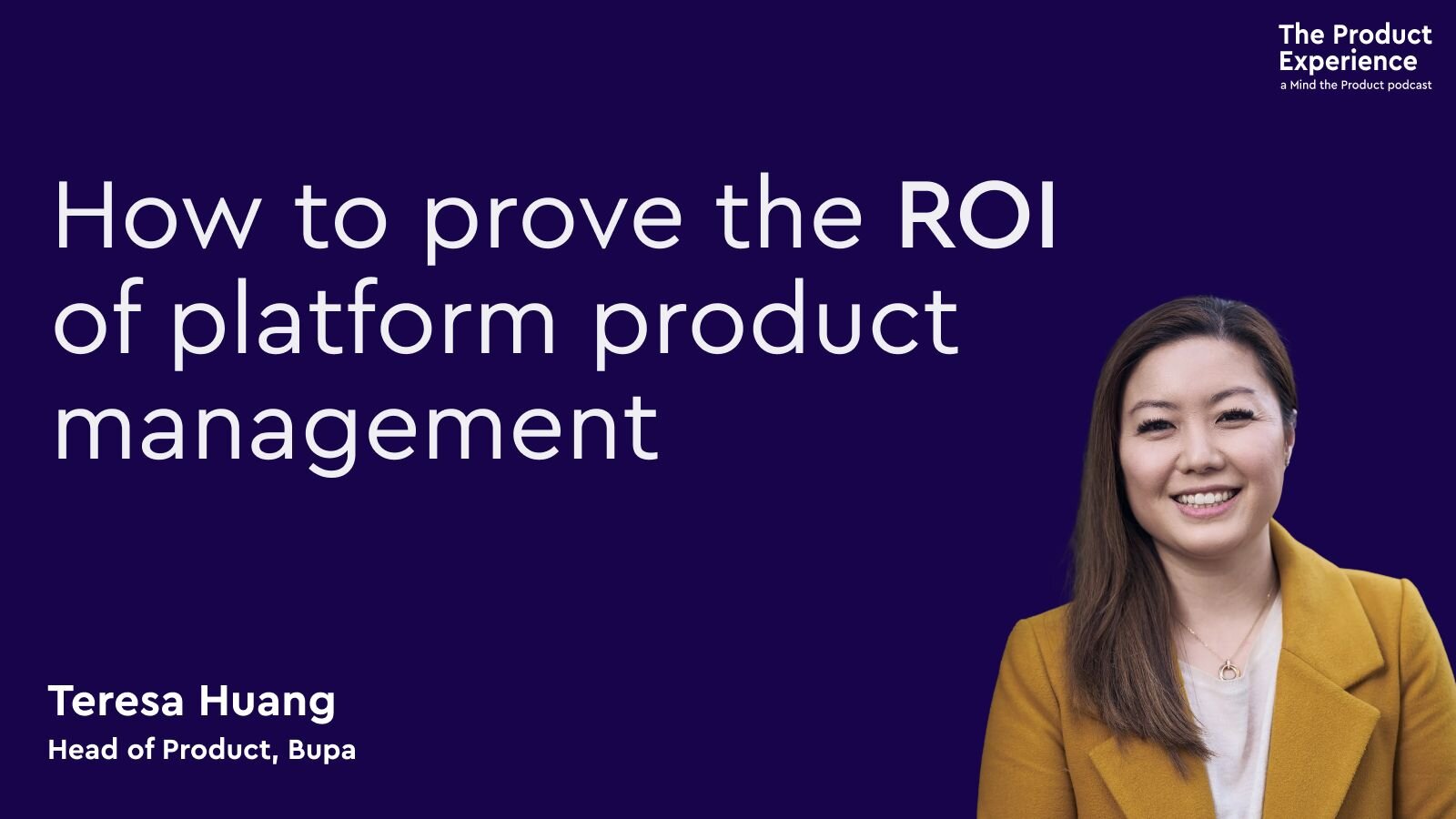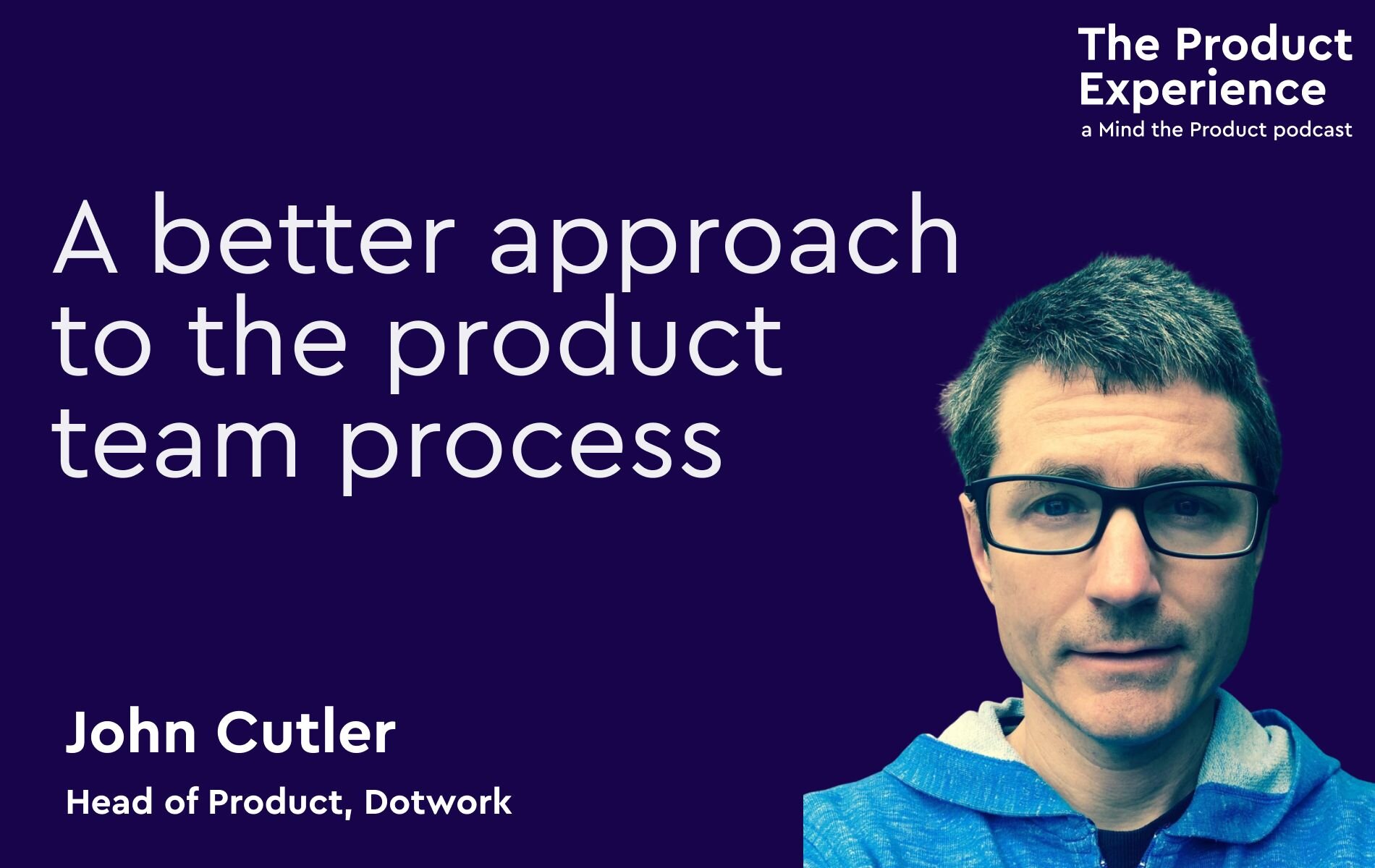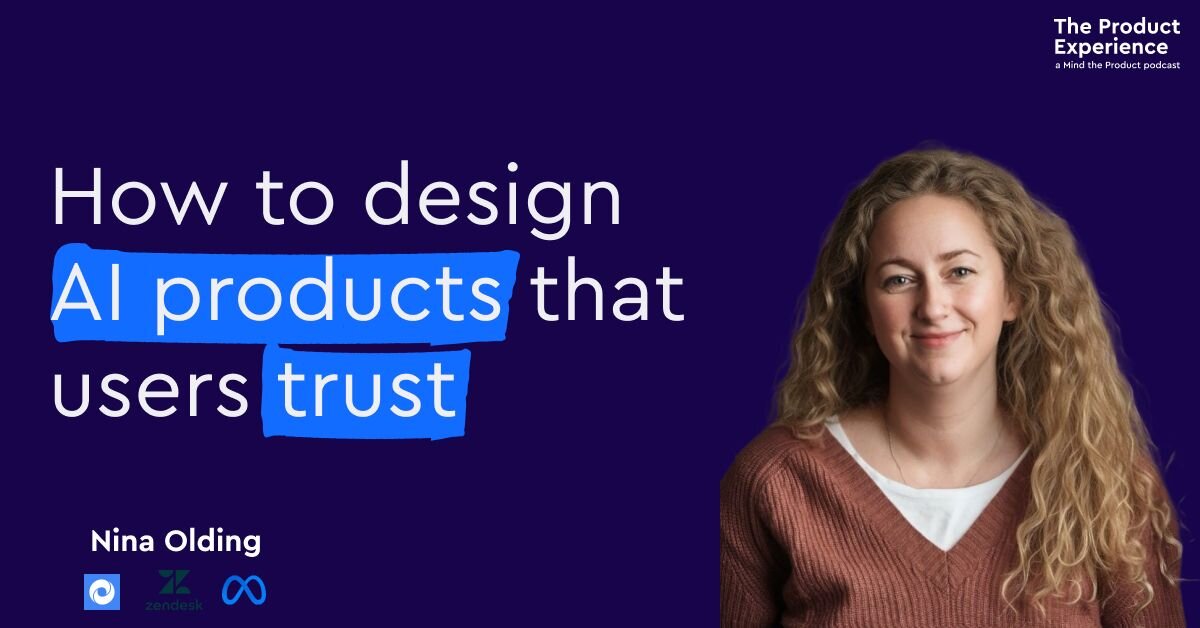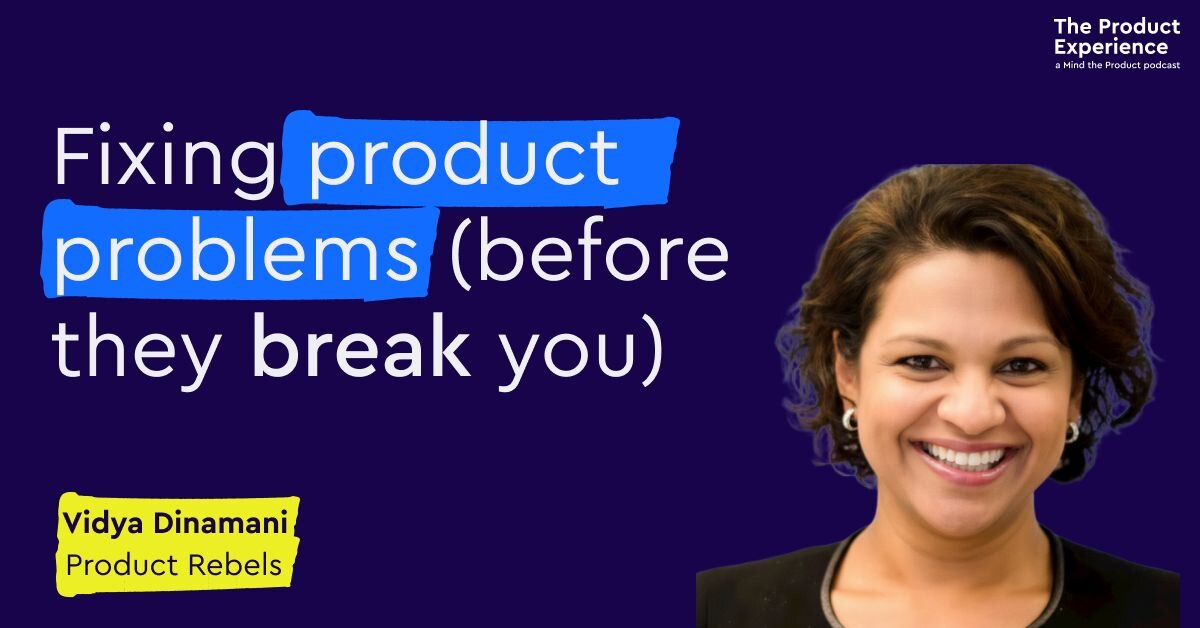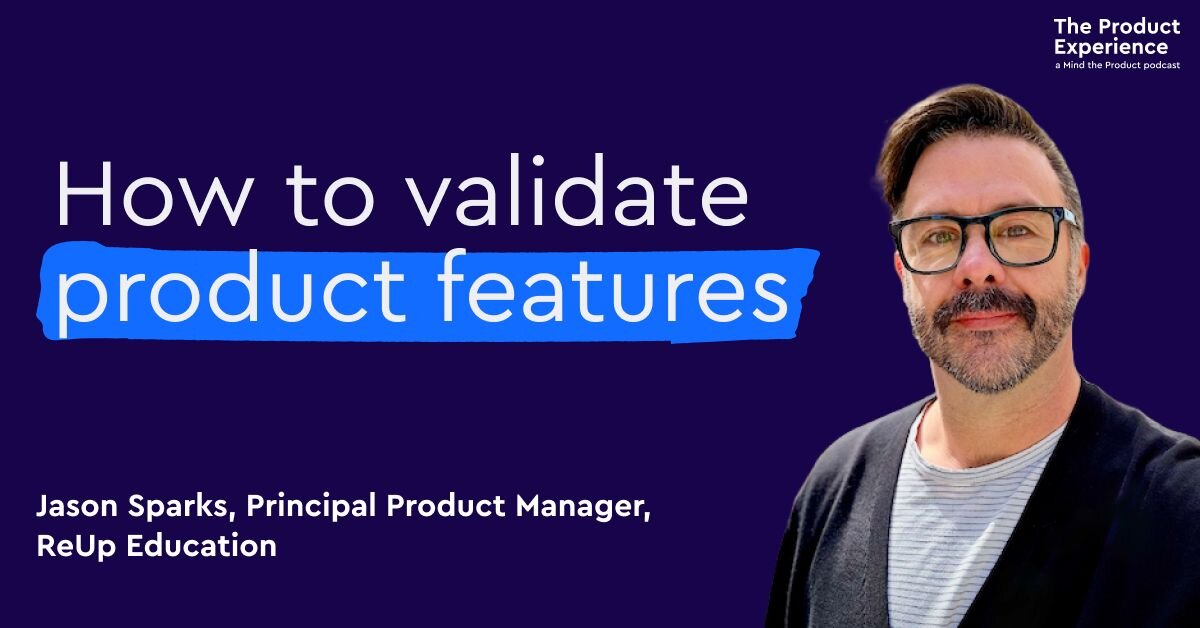It's a common saying that 'ego is the biggest product killer'. In this weeks' podcast episode, CPO at R-Zero, Tony Poon, delves into a discussion with Lily and Randy about how to ensure that your ego doesn't get in the way of discovering and managing the best products.
Featured links
Featured Links: Follow Tony on LinkedIn and Twitter | R-Zero | Understanding the Id, Ego, and Superego in Psychology
Episode transcript
Lily Smith:
You're so vain.
Randy Silver:
Excuse me, Lily. Oh,
Lily Smith:
sorry, you caught me. I was just inspired by this week's chat and Carly Simon just came to mind. You know, you're so vain. I bet you think this products about you.
Randy Silver:
You know, that's not the actual work, but I see what you did there. And I guess it kind of fits. I mean, we are talking with Tony Poon about how you go is the product killer? Yes, because say
Lily Smith:
the stop buys too much of it as well. Anyway, we had a great chat with Tony he is now the Chief Product Officer at zero, who are doing some really interesting things to make office spaces safe and other spaces. And he's got some great tips to stop ego from killing your product.
Randy Silver:
And there's so many pop culture references we could have used in this intro. I mean, stop me before I nerd out and drop one for dude, you know, but how fear is the mind killer.
Lily Smith:
Up Stop, stop. I'm getting you off. Okay, quick, let's get straight into our chat with Tony. product experience is brought to you by mind the product.
Randy Silver:
Every week we talk to the best product people from around the globe about how we can improve our practice and build products that people love.
Lily Smith:
Because it mind the product.com to catch up on past episodes and to discover an extensive library of great content and videos.
Randy Silver:
Browse for free, will become a mind that product member to unlock premium articles unseen videos AMA's roundtables, discounts store conferences around the world training opportunities for
Lily Smith:
mining products also offers free product tank meetups in more than 200 cities, and less probably. Hey, Tony, thanks so much for joining us on the podcast. It's great to be talking to you today.
Tony Poon:
Thanks for having me. I've been excited to have this conversation.
Lily Smith:
And before we get started, it would be great if you could give us a real quick intro into who you are and your product origin story.
Tony Poon:
Or boy, what orgies are so my name is Tony Poon, currently Chief Product Officer at a biosafety solution company called our zero origin story. Oh, definitely one of the classic story of accidental product management started out as super nerdy engineers in a dungeon type style. It's in semiconductor of all things. So device physics and things like that, learn really, really good discipline around kind of single on bat, don't screw it up type engineering disciplines. And then I started asking the knowing question of why am I building this feature? That's really a hard question to answer in semiconductor because you're about 12 steps removed away from the use cases. It turns out, they boot you in those kinds of scenarios. This kidding, but so that, that led me to kind of moving on from silicon and then doing system level work. And then that's when I got exposed to software architecture. And more importantly, asking questions around use cases, then, kind of following that train eventually became a product manager, and then kind of more and more from product into solutions into enterprise, done a few interesting things, all of which are mostly intersection of physical and digital worlds, I tend to love those complex problems. Recently, I did drones for industrial companies, mainly my mining and constructions. And then I fell in love with the mission that we are currently at, which is kind of making indoor spaces safer for wherever we, the world turns out into next for hybrid working or whatever it may be certainly pertinent conversations nowadays. That's that's a little bit about how I came into or fell into product management.
Randy Silver:
Well, we get into everything else. 20 or zero. sounds really interesting. You just tell us a little bit about what it is you guys do. And what is it you've got physical and I'm guessing software involved? What does Product Management for biosafety actually look like?
Tony Poon:
Yeah, it's so our zero, it's, we're very much about enabling people to have an outcome, which is an indoor space that's safe, and is really surrounding around pathogens and things that we don't see and certainly, again, a pertinent conversation as of last few years, but it turns out that the problem has existed way longer, it just has been spotlighted on to him. So what we really do is we build a bunch of technologies in hardware and software and environmental sensors. seeing and understanding what is the level of risk in a space, it could be pathogen risks, it could be viral risks Vukmir, yet many risks. And we deploy mitigation in an autonomous way using sensor to make sure that we do those things. And then marry that with software to help connect the outcome of a space or space to business outcome for different types of organisation. A lot of them are currently folks like education, government, or large scale organisation that really have a strong in person culture has been a challenging, not watered navigated the last few years, I'm trying to understand how do we continue to drive productivity with certain muscle memory about how we converse with each other, also learning digital the same time. So this kind of goes into that entire conversation of what the future of work looks like, also.
Lily Smith:
And that must have been really interesting period with COVID. coming along. How did that this is not our kind of topic for today. But just curious, as we're talking about it, like how did that impact the way that the team was operating? Were you just kind of on this mission anyway? Or did it change the strategy or the plan in any way?
Tony Poon:
Oh, it was a really good question. Actually, a company is fairly young, it's only two years old. So it's definitely one of those battlefield formations. Where, you know, I'm actually not one of the co founders, but the co founders basically saw a need in the world and, you know, human catastrophe that was kind of happening around the world, they wanted us to do something about it. So that's really where the founding story came in. And it turns out that there existed a set of technologies that were stuck in hospitals for decades that didn't really get democratised, or become accessible, and wasn't really modernised to a way that it was, let's just say accountable and attributable to outcomes. So that's really what we did we set out on the mission really is how do we help people come back to the world in a safer place, but in a way that is measurable and attributable. And I think the folks that it was one of the strongest mission aligned team that I've ever seen, most unfortunate, again, there's a catalyst in the world that's very vivid to all of us. But even beyond that, being able to connect to something that we all experience, which is, you know, 90% of the time that were spent nowadays are indoors, we go outside to go to get inside. So it's a very vivid relationships of what a better outcome would be, either for the industry, as well as for ourselves personally.
Lily Smith:
Yeah, I think that's really interesting. And, but when you have innovation that happens as part of like a big crisis like that, then these are the kinds of products and businesses that are so fascinating to come out of that experience. And yeah, I'm excited to see what you guys do. But let's move on to our topic for today, which is all around our own personal egos, risking killing our products. So tell me about this. Like why why do you think ego can risk killing our products?
Tony Poon:
For so many scars? So, so many scars from personal scars are out these still getting them? I think ego is like a very high level summary of not truly hanging on to the customer needs. I mean, I think ego at the end of the day can be described and manifest in different ways in our product management kind of cycle. There's like overconfidence, there's optimism, there's fear of being challenged, there's like supremacy, like there are different forms of egos that get injected throughout the cycles. But I think all forms of them, at least that I have experienced ends up taking us down a path that does not match the customer need. And ultimately, I think ego or not, or maybe there are even other factors in it. It's really about how do we lose sight of customer need, and therefore potentially building towards symptoms that didn't solve problems are building to something that people actually didn't need in the first place, which is kind of the worst case scenario. I've been through that many, many times. I've seen teams go through that many, many times. And we continuously try to not get into that space. And I find that symptomatically more frequent in connection back to our original conversation with more passion driven teams, where, especially around startups, where you, you necessarily start with something very passionate, you believe in something you want to change the world. And you may not have all the data to say that you can but that's how it starts. And making that conscious transition from Passion Driven into data or conviction driven, has always been a challenge continues to be challenged with every team. And it's something that I'm always trying to be more I in full of including myself on, do I have data to say that? Or am I saying that? That's really where I see ego gets injected a lot into different parts of the development cycle?
Randy Silver:
I mean, you just said you're talking to ego driven. You talked about data driven. And I know this, but I think you also mentioned conviction driven. What's that?
Tony Poon:
Interesting, not trying to redefine words in dictionary, but the way I defined them. It's really bouncing, especially in this in the types of fast pace Passion Driven startups that we're in. There's a passion versus conviction conversation that I always have with my team, it's very easy for us to get really excited about solutions to problems, we might not even research and architect the solutions. And we feel so heartedly that that is the right way and the best way to solving it. But what we end up finding a lot of times is that there isn't enough data to support that the problem is worth solving. It isn't that we have challenges in solution space, is we don't necessarily have to clear enough understanding of what is the problem space, and what is the value to wish that we could generate for the customer. And to me, that's really where to transitioning between passion into conviction, which requires data. For us, we always try to be conscious about well, how far do we want passion to drive us? And how much do we need data in order to get important, at least large size t shirt size decisions, so to speak, that we have the conversation? And we don't we may not use those words explicitly. But really the question is, how far do you let the team push on pure passion and ideas and excitement? But how do you throttle them back into what are the facts? What are the personas actually telling us versus what we think the personas need?
Lily Smith:
So you've said that you've seen this issue like multiple times and kind of suck. But in my experience, like a lot of PMS are notoriously just full of self doubt, and suffer impostor syndrome. So is this really do you think this is really quite a widespread problem? And is it? Is it within the sort of product management role, or just across the whole business?
Tony Poon:
Oh, interesting, I think it comes, this might be something that you're trying to tease out, which is different personalities, and they react to risk differently. And I guess for the good of the last past decade or so, gosh, I'm dating myself a little over a decade, I've been kind of earlier side, it seems a Series A, B, and C, we're really trying to find product market fit, where most teams in these cases are full of ideas, but trying to chart a course. And then on the other side of that, when you have a more mature product, when you're trying to not screw up something, so to speak, I think is where I sometimes see what you are mentioning is like, Well, is it really worth the risk? But I think regardless of those conversation is still comes back to are we driving purely on ideas or mostly on ideas? Or are we having data rooted conversation so we can have tangible decisions that we're making? So I guess, from what I've seen, the degree of which people lean in and excitement that they have about their own ideas, and a conviction, land varies depend on personality and maturity of the product, or the stakes of screwing up existing things, so to speak. But the transition into being conviction driven? It's it's fairly similar. And the requirements there are always the same, which is, do we hear it from the customer? And do we understand what the value is coming from the solution that we were proposing?
Randy Silver:
It sounds really straightforward, but it always does. And I recognise everything you're talking about, but just make sure we're all on the same page and help everyone else who's listening. And especially to help me how do we recognise when we fallen into this trap? How do we what are the signs that you've tipped over the balance?
Tony Poon:
It's so important to have a question. I know playbooks to be quite honest. It'd be silly, if I said, like, here are five things coming from tablets, read them and use them. But things that I've tried and have a reasonable degree of success, at the very least are helpful, is incredibly important and powerful when people start writing things down. It's surprising It's simple. It's almost sounds like well, okay, I don't need you to tell me that. But the second or the moment people start writing some things down. You start to have the compositions of writing force you into those moments of hesitation, and question yourself, Where does a source of this information come from? For example, like when you start writing out use cases starting with In the personas name versus your name, something as simple as that gives you like this, like split second pause, whatever the descriptor is, you're describing the use cases subsequently in that sentence, chances are, you have to have three thoughts before writing the second part of it. And it had that much higher probability of being coming from a customer than yourself.
Randy Silver:
Are you writing user stories that says, As Tony's want, I shall.
Tony Poon:
But you know, sometimes we get so busy, we just want to crank them out. And we feel like, Oh, we've done so much research, we understand this thing inside. And now we've been in so many hours. And sometimes actually, the more research you do, the more confidence that you build, the more it has a tendency of getting away from you, because you feel like you get it. And sometimes when you feel like you get it, you lose sight of the nuances in the workflow that the customer has. Because some of them to be quite honest, workflows don't always make sense that none of them are always logical or rational. But that's the point. Right? It's like, if we could reason our way into this is a perfect workflow, like all you got to do is get trained and you'll be successful, like, then we don't need product managers. So I think a lot of times, it's the more knowledge or sometimes the we lose sight of the nuances that is of our customer. And then getting routed back into that it's always always better than trying to drive towards what is an ideal workflow and ends up having a gap that you didn't realise until it's too late.
Lily Smith:
Okay, so this sounds very familiar to me all of this, I wonder whether it's also more predominant in startups where you have founders who have come up with an idea. And they're, you know, they've got a problem that they're solving for a market, potentially, they have some of the sort of knowledge and information about that market already, or some some kind of subject matter expertise. And they want to move quickly. And so they're like, just build some, all of these features, because I know these customers, and this is, this is the product that I am building, this is what I'm launching. And I imagine actually, to an extent there's that within bigger corporations as well with sponsors for particular products, or business models, or whatever it may be. So how do we coach a different way of thinking for those executives who are typically probably more likely to come with the the non data driven and more that driven ideas?
Tony Poon:
So first of all, guilty, guilty the whole time, in many different roles in different teams. I think that the thing that seems to work that I've seen and I got to try to practice as much as I can, is being not not penalising people for asking questions. And it's, it's like a principle, we all know, we should do that. And, but sometimes when you know, push comes to shove, or unscheduled pressures are high or stakes are high, you just want to get something done. And you're not as open minded for people to sometimes challenge the root assumptions, because you feel like you've already moved with pass it. But what I have found is, if somebody challenged the basic premise of the proposal or their solution, and there isn't a clear answer, and you just want to move past it, because you want to just go MC scheduled, that's actually a very, very good place to pause, because you couldn't come up with a very concise way of describing what the value is. And I think on the other side of that, for folks that are dealing with folks like myself that sometimes you gotta go do this, like so obvious. Don't be afraid to ask those questions. I may ask them in a way that makes sense, give context. And like, you know, don't don't do it in 50 different separate questions, but as a concise one, or two, and make sure that there is in a satisfactory answer for both sides so that we can move forward because to be honest, 50% of our jobs as product people are to align different teams so that they can do their best work. And what better way of being able to enumerate the reason why we do something very cleanly, so that everybody can line up to it.
Randy Silver:
It's been in so many different situations on this. And I'm afraid I don't have a good answer for this anymore. Because I've been in places where it's exactly that it's, Hey, let's get into a better conversation. Let's get to articulation of perception and value and things like that. So that we know that we're all working on the same thing for the same reasons with the same assumptions. I've also been in places where it's quicker and easier to just run an experiment. So we can at least say we tried it and come back with data. And whether it's that or it's, we're dealing with a tough stakeholder and it's better to see face by doing that and Yeah, rather than challenge them is, is this dependent on the situation? Or is there do you think that conversation is always the best way out?
Tony Poon:
Oh, that's such a great conversation. Politics are weird, and none of us really want to, like, address it head on. But like, look, as much as we don't think is productive, it's there. And I think you said it perfectly. Sometimes you just have to have different band aids for those kinds of problems. I think ultimately, every time I, I have approached these problems I have seen problem handled, and others handled me is through depersonalization. The things that work the best are however, it is that you can D personalise a conversation and refocus back to the problems and customer space. It could be presenting things that are coming from metrics or dashboard, or even industry studies, sometimes even look at competitors. Because we can't assume everybody else is stupid. And sometimes when it gets to be, like, really, really Passion Driven, where those people are still growing ranks, or I think addressing those things in a larger scope, the personalization effort would be things like, like, how do we do this in two weeks? And really answer very quickly, but be very, very precise about what is our hypothesis, so that we can answer them cleanly and move on. And I think that's actually a very important nuance and what you just said, which is, you know, when somebody become very passionate, a simple question is, what is it that you think, is the reason why we want to build it this way, forcing the other side, to write it down in a clean way, actually, often is a very interesting and productive exercise. Because one, you can understand better on what they really, really think is their hypothesis and why it's beneficial. And the other is to force the other person to really start pushing themselves on being able to educate others on why there's so much conviction, at least from their point of view, and then using that would be a perfect way to drive an experiment.
Randy Silver:
Yeah, I think it's a big one when I when I manage or coach people is you may be right. It's entirely possible. Yeah. And it's also possible that the other person is right. But how you manage that relationship to figuring it out. And moving forward is incredibly important. It's not always about being right. It's about how do we get agreement and have the right conversation to move forward together?
Tony Poon:
Absolutely. I it's never really to perfect decisions, but it's really about moving forward in a way to build on conviction.
Lily Smith:
Yeah, I love that. And I think that point about, you know, just going ahead sometimes and doing an experiment, if you have a senior exec saying, I want you to build this. And you're like, Okay, what impact do you think it's gonna have? And they like, it's gonna, like, two times the conversion rate or whatever. And then you do it and you're like, Okay, we run a good conversion, and it's done nothing. And then like, okay.
Tony Poon:
It's very effective against me to be quite honest, it forces folks to pause and just be like, Okay, what I really believe, because I'm about to be written up, so to speak, is good lasted around this experiment is going to have my name on so I better think twice before I just hand wave and say thou shalt do.
Randy Silver:
So something that's come up a lot on on Twitter, and I'm so sorry for for citing Twitter's as a source of things. But something I've seen good come up in conversation a lot over the last couple years is the idea of people having an innate product sense. Or you talk to people in the industry who have, you know, their experience and their gut on things? When do you go with that versus going with you and saying, This is a good first approximation, or let's try this first, versus starting with actual data?
Tony Poon:
Oh, that's interesting. I think it depends on the goals that for the team. Speaking from more from a personal experience perspective, when it comes to before product market fit. The goal is really to experiment the crap out of it so that you can minimise possibilities. Because you're nothing but possibilities, you have so many ideas, you don't even know what to do with. So in those instances, where in some ways, you have nothing to lose, but time and you're trying to focus as much as you can onto something that you want to spend more time on there. You know, we typically try to do more, and then get early antidotes so that we can start using that as a framework for filtering. And I think for folks that have established metrics and established businesses that already kind of running, being much more data centric and making decision based on tangible data are much more important because you would be that there's the stakes are higher and then there's screw ups or Eriko screw ups are much more visible and have tangible impact. Back to the business that you may otherwise cannot afford. On the other side of that, so for us is much more, if it's before adoption, we understand how much effort we want to put into it, and we understand the risk. And in on existing products, we try to size it small enough so that we can get quick answer before we start making, you know, medium to large T shirt size experiments. So that we can really ease our way into it and increase the level of de risking before pulling the trigger on on some of those projects.
Lily Smith:
And just to come back to some of the terminology that we use when we were thinking about this topic. So the kind of the concept of the ego is the product killer and an ego being that sense of sort of self importance or self worth. Oh, he basically saying that, you know, we can't kind of tie in sort of those micro successes of the product, and take pride in those or kind of use them to fuel our, our own self worth. Do you see what I mean?
Tony Poon:
I do I? Maybe I've just broken in that way? Well, I don't know. First of all, I think every product manager have their own reason for why they want to take on this crazy role. Because like what product managers do is we can't even describe really wholeheartedly what all product managers, we just do stuff to make sure that products are successful. And that's that part. For me, though, it isn't really about my ideas, it isn't really about being right. I think at the end of the day is about the impact of whether or not decisions that you and the team made resulted in something that we wanted or more. I must say not don't celebrate being right, or don't celebrate being creative, or don't celebrate ingenuity, like those are team wins and personal wins to some degree. But that's not, that's not really a product when, in my mind. So I guess my approach all is always celebrate with the team about ideas. But the victory has nothing to do with any one of us. It has everything to do with whether or not the customer got value. So and that's, that's the type of product team that I gravitate towards. And celebratory moments are a kind of fleeting, but the durable, celebratory things for the team is really about like, look at all these metrics that came out of it. And not only were we right, we we were actually wrong, because he actually did way more. Those are the things that you actually tend to remember a year or two or three years after, what I find is like those micro moments tend to fade away pretty quickly, from the things that stick around or like, Look what we did for this customer look what they were able to do get out of that the business impact that we were able to generate. So those tend to be at least naturally, at least into teams that that I've been part of tend to be the things that bubble up as people cherish those the most. In terms of personal, celebratory things, I don't know I those haven't really been something that I have focused too much around. Team celebration has always been more important.
Lily Smith:
Yeah, I love it. And just thinking about my own kind of journey and products. I know definitely earlier on in my career, I felt like I should have all of the answers. So I felt like I should come with like all of the ideas and they should all be right. And I should have a plan of all of these things and they're all going to like have a positive impact. So I you know, I'm wondering if there are kind of more junior product people out there who get stuck in that trap of, you know, they their ego is concerned that they're going to be perceived as being inexperienced, because they don't have the answer, rather than their answer is. We don't know what's going to happen. So we need to, like get the data.
Tony Poon:
It's a really good question. That's a really good question, I think is really important to not mistake or not over rotate. I think from like not being egotistical to not being creative or innovative. I think those are like two very separate things. being creative and being intuitive in how and where problems may be it is a product manager superpowers to some degree. We, the team kind of rely on us for those because we are synthesising data. We're putting our nose to the ground. We're sniffing it out. So it's not that I'm suggesting for us to not take the lead in proposing or take the lead In pointing or providing guidance, I think it's really about as we do that, how do we help the team de risk what we say or what the team believes. So I, I personally tried to be the least creative person in the room, mostly because I happen to be part of bigger and bigger teams now. So me being the most creative, it's usually problematic and ends up being egotistical. But as you're part of your own team, being creative is actually the first step of you being able to get excited about going around proposing solutions. So it isn't being egotistical if you're trying to be creative, innovative, it is the execution of those ideas without data that gets you to a place where you're more than likely in the eagle land and conviction line.
Randy Silver:
So if you're doing this, well, if you happen to remove ego, it also means that sometimes you're going to be face to face with someone who's asking you a hard question. And the best answer you can give is, I don't know. The problem with that sometimes is the having the confidence to say that and maintain a relationship with people to get for them to walk out of the room and continue the relationship of having confidence in you when you say I don't know a lot. Is there any guidance, any practical advice? You haven't had to do that elegantly? How to maintain relationships, how to keep things going, when you're admitting? I don't know?
Tony Poon:
How I, I say, I don't know all the time, just about maybe every hour. Things. I feel like, at least when I use it on people, where people use it on me that always tend to end up being tangible and impactful next steps? Or if there's a two part I don't know, like, I don't know. But here's what we're going to do. But I don't know. And this is why is less important. So that that second part is what brings it home of not only is it that we are genuine about our knowledge, but we also have a plan. Well, we have an opinion, we have a point of view. I think maintaining relationship and trust and still being in control your quotes. It isn't the fact that you understand everything, it is the fact that you understand what to do to get to the answer that you need. That to me is far more important. And I would assert that it's far more important for us to project than whether or not we have the right answer. As matter of fact, somebody who comes to me every single time with I know the answer, you start to take a pause on like, do you really know the answer? Like let's talk about this. So I would much rather folks start with the I don't know, but follow up with here are the plans. And here are the reasons why that to me genuinely builds trust, rather than just taking an answer at face value.
Randy Silver:
And then I'm going to push you just to go one step further on that because thing, I don't know, but we'll find out or but we ever plan or or that's great for the moment. But what did he do? It can't just be that kind of episode. Sometimes people will also ask you something you generally don't have a plan for yet? Because I don't know. But I'll find out and get back to you. When there's that second part of actually following through on that. Isn't there having a plan when you walk in the door to see how you're going to handle the things that you don't know, how do you get better at that? Well,
Tony Poon:
I think one of the interesting thing about this is when you genuinely don't know and you're literally not only do I not know, I actually don't know what to do, that's a perfect time to ask for help. One of the things that I've realised over my career that I had sucked at is learning that is okay to ask for help, and how to ask for help. Because when I didn't do that the team and the product suffered because there was leverage inside or outside the company that were not applied. So to me, it isn't trying to get to an answer or get to a point when you realise you don't have either. It is about recognising that you're at that step and admit and go try to ask for help. That's going to get you to be unblocked on either having a plan to go find out or actually genuinely getting to the answer. So to me like that's a third possibility in this, which is I don't know, I have a plan. I don't know I don't have a plan. Here's a help I need. I guess that's the third part when the two part don't work.
Randy Silver:
And I'll just keep going with this. Any practical advice on good ways to ask for help?
Tony Poon:
Oh, boy, that I'm still a student at that craft to be quite honest. I think asking for help without context is very hard for the other person to react to. So one of the things I've learned is, before asking for help ask myself how could somebody help me and how When I enable somebody to help me asking yourself that question first before asking a question tend to have a higher probability of a productive conversation after, because a lot of times what I found in the past, I was asking for help in a frantic mode, where there was no information being exchanged. There was no context like, I don't know what to do like that is never a good ask for help, because nobody knows what help you need and what the situation is. So being prepared to give the information the person that you need help from and then formulating that question to me has always yield a dividend. It's just spending that moment of time to organise your thought, so that asking for help is productive. That has always worked for me. And I've always appreciated people that did that with me, so that I can actually spend the right time to go say, one do I know how I can help you or two, here's how I help you a three. Here are the other people that I know would know something about this to help you
Lily Smith:
30 That's such good advice. Thank you so much for joining us on the podcast today.
Tony Poon:
I've always learned something every time I talk or nerd about products so thanks for having me today.
Lily Smith:
The product experience is the first and the best podcast from mine the product. Our hosts are me Lily Smith, and me Randy silver. Louron Pratt is our producer and Luke Smith is our editor.
Randy Silver:
Our theme music is from Hamburg baseband pow. That's P AU. Thanks to Arnie killer who curates both product tank and MTP engage in Hamburg and who also plays bass in the band for letting us use their music. You can connect with your local product community via product tank regular free meetups in over 200 cities worldwide.
Lily Smith:
If there's not one near you, maybe you should think about starting one. To find out more go to mind the product.com forward slash product tank
